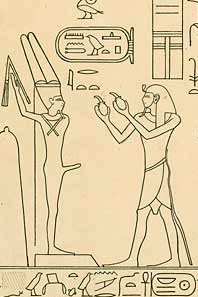Mentuhotep IV
| Mentuhotep IV | |
|---|---|

Mentuhotep IV (right) gives offerings to Min. From Wadi Hammamat
|
|
| Pharaoh | |
| Reign | 1998–1991 BC (11th dynasty) |
| Predecessor | Mentuhotep III |
| Successor | Amenemhat I |
| Died | 1991 BC |
Nebtawyre Mentuhotep IV was the last king of the 11th Dynasty. He seems to fit into a 7-year period in the Turin Canon for which there is no recorded king.
He is known from a few inscriptions in Wadi Hammamat that record expeditions to the Red Sea coast and to quarry stone for the royal monuments. It seems that he was a son of his predecessor.
Also, he is attested by the inscriptions at Wadi el-Hudi. Another relevant inscription is found in Ain Sukhna. These locations were the usual staging harbours for the expeditions to the Sinai.
Despite Mentuhotep's obscurity (he is absent from the official king lists in Abydos), the inscriptions show the organization and makeup of a large expedition during his reign. The leader of an expedition to Wadi Hammamat, during the second year of Mentuhotep IV’s reign, was his vizier, Amenemhat, who is assumed to be the future king Amenemhat I, the first king of the 12th Dynasty, and Mentuhotep's immediate successor.
A fragment of a slate bowl had been found at Lisht North that is inscribed on the outside with the official titulary of Mentuhotep IV, and on the inside with that of King Amenemhat I, his successor. Since the two inscriptions are incised in a different style of writing, according to Dorothea Arnold, this indicates that Amenemhat had his name added to an older vessel that already bore the name of Mentuhotep IV.
It is assumed by some Egyptologists that Amenemhat either usurped the throne or assumed power after Mentuhotep IV died childless. There is currently no archaeological or textual evidence to prove that Mentuhotep was deposed by his vizier or that he chose Amenemhat to be his designated successor. Neither his mummy nor his burial place have been found.
...
Wikipedia
